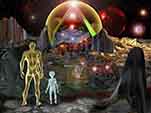CONTINUATION OF VP's Above 'Port Arthur Mass Murder' Post
(He is suddenly unable to finish posting this. Considering the subject matter, I'm not suprised!)
------continued-------------
Rees had commanded 300, mostly Tavistock-trained Army
psychiatrists; since then, Tavistock has been almost
indistinguishable from the various wings of British Military
Intelligence (MI-6, MI-5, SAS, etc.)--a connection perhaps of
relevance to the military precision with which Bryant planned and
executed his mass slaughter. At the war's end, in a speech to U.S.
Army psychiatrists in 1945, Rees called for the creation of
"psychiatric shock troops," who would move out of the military and
psychiatric institutions, in order to shape society as a whole:
"If we propose to come out into the open and to attack the social
and national problems of our day, then we must have shock troops
and these cannot be provided by psychiatry based wholly in
institutions.
We must have mobile teams of psychiatrists who are free to move
around and make contact with the local situation in their particular
area.... In every country, groups of psychiatrists linked to each other
... [must begin] to move into the political and governmental field."
The "mission" Rees outlined, was to create a situation "where it is
possible for people of every social group to have treatment when
they need it, {even when they do not wish it}, without the necessity
to invoke the law" (emphasis added).
Tavistock's methods were outlined by Dr. William Sargant in his
1950s book, {The Battle for the Mind: A physiology of conversion
and brain-washing.} A pioneer in the study of "shell shock,"
Sargant also emphasized the work of Soviet psychologist Pavlov in
the 1920s and 1930s, in particular an incident in which a rising
flood trapped some of Pavlov's dogs in their cages, while the water
rose up to their heads, before receding. Pavlov found that the
intense fear the dogs experienced "wiped clean" the tricks they had
been taught, following which they could be "reprogrammed."
Further experiments by the SAS/SIS during the 1950s, including in
Malaya and Kenya, showed Tavistock that such stress, with
resultant "reprogramming" capabilities, could be applied to entire
societies.
In a 1961 series of lectures at the University of California Medical
School, one of Sargant's closest collaborators, British novelist
Aldous Huxley, assessed the notorious MK-Ultra mass drugging
and brainwashing experiment which had been under way since the
early 1950s. Huxley was the author of the 1952 book, {The Doors
of Perception,} which first popularized LSD usage; he had long
before fictionalized the results of such experimentation in his novel
{Brave New World}. Huxley himself played a key role in MK-
Ultra. With such methods, Huxley now said, in 1961 lectures
entitled "Control of the Mind," there will be a "method of making
people love their servitude and producing dictatorships without
tears, so to speak, producing a kind of painless concentration camp
for entire societies, so that people will in fact have their liberties
taken away from them, but will rather enjoy it, because they will be
distracted from any real desire to rebel--by propaganda, or
brainwashing, or brainwashing enhanced by pharmacological
methods.
And this seems to be the final revolution." Another pet project of
Huxley's from the 1930s on, was the creation of what he called the
"somatotonic personality": one who would not hesitate to murder.
The Tavistockians operate with a construct of the human mind as a
{tabula rasa} that can be imprinted, or a mechanical system that can
be manipulated by such techniques. Since the essence of the human
mind is, on the contrary, its inherent creative capability,
Tavistockian brainwashing works only if the brainwashers can
create a "controlled environment," in which the victim sees only the
alternatives presented by his tormentors. - Tavistock deploys to
Australia - In the early 1950s, Rees sent two of his "psychiatric
shock troops" to Australia, Dr. Eric Cunningham Dax and Dr. Fred
E. Emery.
Dax had written a chapter for Rees's 1949 book, {Modern Practise
in Psychological Medicine}, and had trained at the same hospital
where Rees had practiced. Dax was also a protege of Sargant.
Sargant had initiated a brainwashing technique called "deep sleep,"
in which patients were given massive doses of drugs, to keep them
asleep 20 hours or more a day, which increased their susceptibility
to "programming." Under Sargant's tutelage, Dax performed 1,300
experiments in deep sleep, and rapidly became one of Britain's top
practitioners of so-called "physical methods" of psychiatry, which
included pre-frontal lobotomies, on which Dax wrote a monograph,
and electric shock, which was often administered during "deep
sleep." The acknowledged problem with "deep sleep," was that up
to 2% of the patients subjected to it, died;
those who lived were often psychologically destroyed. Arriving in
Australia In 1952, Dax set up the Mental Hygiene Department of
Victoria, which in turn set up Australia's entire mental health care
system. As Rees said in his introduction to the book he told Dax to
write, {Asylum to Community: The Development of The Mental
Hygiene Service in Victoria, Australia}: "The Mental Hygiene
Service of Victoria, may, indeed, have provided a major training
ground in psychiatry and mental health work for all the English-
speaking populations of the South-western Pacific region, and this
is a matter of very great importance."
The second Tavistock brainwasher whom Rees dispatched to
Melbourne around the same time, and whose work would help
shape Dax's own, Dr. Fred Emery, set up shop as Senior Research
Officer in the Department of Audio Visual Aids at Melbourne
University. There, Emery began conducting experiments on
schoolchildren, as described in his article "Psychological Effects of
the Western' Film," to see how "oedipal patterns" could be induced
in schoolchildren--a subject of some relevance to 28-year-old
Martin Bryant, and the mysterious deaths of both his father and
Martin's own elderly girl friend.
By the early 1960s, Emery, together with the chairman of
Tavistock's governing council, Dr. Eric Trist, was giving lectures to
select audiences at Tavistock on methods to brainwash entire
societies. In this new age of mass communication, they said, a
series of short, universal shocks would destabilize a targetted
population, plunging it into a form of "shell shock," a mass
neurosis.
If the shocks were repeated over a period of years, a more and more
infantile pattern of thinking would develop. Emery elaborated these
concepts in his 1967 article in Tavistock's magazine {Human
Relations,} entitled, "The Next Thirty Years: Concepts, Methods
and Anticipations," and in his 1975 "Futures We Are In." In the
latter, he outlined the three stages of this process: 1) People would
"lose their moral judgment"; 2) next, "segmentation"--societal
disintegration--would begin, in which the individual's focus moves
from the nation-state to preoccupation with local community or
family; and finally, 3) "disassociation" would set in, "a world in
which fantasy and reality are indistinguishable," in which the
individual becomes the societal unit.
Emery calls this final result "Clockwork Orange," after the Anthony
Burgess novel, in which habitual, random violence by gangs of
youth is the order of the day, while adults retreat to their television
sets and other forms of "virtual reality."
In 1980, Trist looked back at the last two decades of the
assassination of the Kennedys, of Martin Luther King, the Vietnam
War, the oil shocks, the Iranian hostage crisis, etc., and announced
that the process Tavistock had predicted, had indeed begun, and
would now accelerate. Meanwhile, in Australia, Dax brought
Sargant to Melbourne on Aug. 14, 1962, to lecture on "The
Mechanism of Brainwashing and Conversion." Another of Sargant's
proteges, the Sydney-based psychiatrist Dr. Harry Bailey, was a
fanatical practitioner of "deep sleep," and killed a number of
patients during experiments at the Chelmsford Private Hospital in
the 1960s and 1970s.
The resulting scandal led to the convening of an investigatory
Royal Commission into Deep Sleep, and to Bailey's own suicide in
1985. As reported in the book {Deep Sleep,} by Brian Bromberger
and Janet Fyfe-Yeomans, which chronicled Bailey's experiments,
Bailey and Sargant "remained in constant contact for almost 30
years, and ... Bailey often spoke of the competition between them
to see who could keep their patients in the deepest coma without
killing them."
Dax himself pushed ahead with research on "turbulence,"
"aggression," and "brainwashing"--all from the Reesian perspective
of using psychiatry to shape society as a whole, as exemplified by a
speech he gave at the University of Melbourne on July 20, 1964,
titled "Some Observations on Psychiatric Research." "It is no more
than a few years past," he said, "when psychiatry was solely
represented by the mental hospitals, before the child guidance
clinics were first begun or the psychiatrists started to move into the
outpatient diagnostic centres.... The mental hospitals may be
likened to the grandmothers of community psychiatry....
Within the span of a single generation, psychiatrists have been
thrown from the protective, circumscribed and alienating walls of
these hospitals into a restless, changing and aggressive community,
seething with turbulence, which struggles to adjust to the gathering
speed of mechanization and the disrupting forces of a disordered
society.
"Most of us are more experienced in the treatment of individuals
than in correcting the pathological behavior of groups, though there
may be an increasing tendency to seek our advice in these and
related matters. For instance, the frightening implications of
forcible indoctrination of individuals on the one level and
communities on the other are closely related to our specialty. Yet
almost paradoxically we are driven to consider as to whether
modifications of such methods of indoctrination can be used in the
treatment of some of the psychoses."
Foreshadowing his work on Martin Bryant, Dax continued: "In
many of these fields, the {consideration of aggression is of the
greatest importance. There is no more useful subject for research
studies at the present time, whether it be in the individual or the
group}.
Here, from the individual, the psychiatrist has much to learn. It may
be that the aggression is turned inwards, ultimately resulting in
suicide, outwards in homicide, or more specifically in hostility
towards the community, in causing death on the road...
"Moreover many a murderer has the inability to postpone his strong
emotional reactivity to thwarting, and this often has an association
with a past history of repeated frustration of a variety with which he
has been unable to deal.
Or again, the person who uses a motor car as an extension of his
own aggressive body image may be using it in escaping from his
anxieties and supposed rejection by the community. Yet it seems
that none of these aggressive manifestations would be of the same
magnitude were it not for the effect of alcohol. It releases these
strains by depressing the inadequate control which spreads its thin
veneer over the underlying aggression" (emphasis added).
Precisely these elements were to arise in the Martin Bryant case. In
1969, Dax left his prestigious, highly influential position in
Melbourne to go to the backwater state of Tasmania, an island of
some 300,000 people off Australia's southeast coast. A prominent
U.S. psychiatrist who specializes in ritual abuse, and who is
intimately familiar with Australian psychiatry over the past three
decades, when queried by this news service as to why in the world
Dax would move to Tasmania, replied: "Tasmania is the Appalachia
of Australia.
There is a lot of alcoholism, a lot of incest. It is the poorest of all
the states, very primitive, with a lot of descendants from very
violent criminals from the British days. You will find many people
there with no value system, no super-ego. It is the perfect place for
Manchurian candidates, and for all sorts of experiments. He could
do whatever he wanted there." Something of great interest must
have been taking place in Tasmania, because two of Tavistock's
leading international operatives, the Melbourne-based Dr. Alan
Stoller, a past president of the World Federation of Mental Health
and a close associate of John Rawlings Rees and of Dax, and Dr.
John Bowlby, went to Tasmania for extended visits in 1971 and
1972, respectively. - Dax and Bryant - From early childhood,
Martin Bryant was a very disturbed individual, as British
psychiatrist Paul Mullen could not help but record in his evaluation
for the defense:
"Mr. Bryant was assessed on a number of occasions by
psychologists and psychiatrists.... He was noted to be aggressive,
destructive and very difficult with other children.... There are
references to him stealing, to him having violent outbursts and to
tormenting vulnerable children.... There are records of Mr. Bryant
torturing and harassing animals and of tormenting his sister."
Bryant was notorious among his schoolmates for carrying a green
can of gasoline, which he constantly threatened to pour on things
and set them alight, as he once did so on himself. His schoolmates
would frequently remark, "Here comes silly Martin with his can."
Before long, this behavior brought him to the attention of Dax, as
Mullen noted: "In February 1984 Mr. Bryant was assessed by a
very experienced clinical psychiatrist, Dr. Cunningham-Dax," an
evaluation which set the parameters for all further treatment of
Bryant.
Contacted by an American academic on April 16, 1997 about his
evaluation of Bryant, Dax said, "I left Tasmania in 1983, I think it
was, and I had seen him a few times before that, but I had no notes
on him, except that I thought that he was below normal
intellectually and that his father was very permissive about him.
And I wondered about the boy, whether later he might have some
schizophrenic features. But that is as far as I went."
Judging by the impact Bryant made on another psychiatrist who
examined Bryant soon after, Dax was singularly unobservant. Dr.
Ian Sale, psychiatrist for the prosecution, recalled in a discussion
on April 16: "When he was about 16 or 17, he was examined by a
government doctor for the purpose of a pension assessment. It was
to that doctor that he made some reference to having a wish to
{shoot people}. She still remembers that to this day" (emphasis
added).
Dr. Sale noted that, not only did Dax have "no recall of the
assessment," but that, "unfortunately, the clinical notes that were
made, were destroyed," ostensibly because Dax "was practicing in
the rooms of another psychiatrist. When that psychiatrist died, it
was a provision of his will, that his notes be destroyed, apparently,
which is remarkable.
And not only were his notes destroyed, but also Dr. Cunningham-
Dax's notes were destroyed." The psychiatrist, Dr. T.H.G. Dick, was
also British, and had served as Tasmania's medical commissioner
beginning in 1969, the year Dax moved to Tasmania. Shortly after,
Dax joined Dick on the Medical Advisory Committee to Tasmania's
Mental Health Commission. Despite Dax's fascination with
aggression, suicide, and murder, Dax claimed he knew very little
about Bryant. And, when asked to comment on the relevance of his
associate Emery's "theory of turbulence" for the Port Arthur events,
Dax replied, guardedly, "I don't think I can answer your question
usefully."
Emery himself died in early April 1997, and thus could not answer
the question either. But, Dax said, "The person who knows a good
deal more about Bryant is in the University of Tasmania, at the
hospital there, the Royal Hobart. They did a good deal of study of
Bryant at the time. Professor Jones is his name, but the person who
knew more about him was the research person, who was
particularly interested in Bryant."
Dr. Jones, who is British, and who, until his retirement, headed the
two floors of Royal Hobart Hospital which are devoted to
psychiatric studies, was unavailable for comment. - What the police
knew - As well known as Bryant was to Tasmania's Tavistock
networks, he was equally well known to the police--despite post-
Port Arthur protestations to the contrary--as evidenced in the
following: 1. He had repeatedly threatened to kill some of his
neighbors in Tasmania, several of which incidents, at least, had
been reported to the police. 2. On one of his frequent international
flights, he had been arrested at Melbourne Airport on suspicion of
being a drug courier, in part because he travelled without luggage;
he was taken to the Royal Melbourne Hospital and examined
before being released.
On another occasion, pornographic videos depicting bestiality were
found in his luggage. According to one police source interviewed
by this news service, Bryant's police records indicated a profile of a
"psychotic multiple killer." 3. That profile accorded well with what
his neighbors thought of him, and not merely because of his
frequent threats.
There was intense suspicion among them that Bryant had murdered,
first, his spinster friend and protector, wealthy heiress Helen
Harvey, and then, ten months later, his father, Maurice Bryant.
Eyewitnesses had seen Bryant wrench the steering wheel from
Harvey while the two were out driving, and Harvey had told the
mayor of Tasman Council, not long before the fatal car crash that
killed her and seriously wounded Bryant, "Oh, he's a worry to me
sometimes. He grabbed hold of the steering wheel coming down
today, and nearly pulled me off the road, going silly. What would
you do with him?"
On Aug. 16, 1993, Maurice Bryant was found, wearing weight
belts, dead at the bottom of a dam on the property formerly owned
by Harvey, which she had willed to Martin Bryant. Bryant had had
numerous arguments with his father, who moved onto the property
the same night that Harvey was killed; his son was particularly
bitter that his father was getting rid of the menagerie that the
younger Bryant and Harvey had collected. After his father had
disappeared, {but before his body had been found}, Martin ran into
neighbor Marian Larner outside the local hospital.
As Larner reported to the police shortly thereafter--who never
questioned her further--Bryant had accosted her excitedly, grabbing
her by the shoulders: "Oh, Marian, it's so exciting. So exciting!"
She asked, "What are you talking about, Martin?" "Dad's at the
bottom of the dam," he replied. "You'll hear all about it soon.
You'll read all about it." And, when the elder Bryant's body was
soon after pulled from the dam,
"The searchers were amazed to see Martin walking back from the
dam, laughing," according to a book about Bryant, {Suddenly One
Sunday,} by local journalist Mike Bingham. Several days before,
another neighbor, John Featherstone, had run into strangers
inquiring about a boat which a man named "Martin" had advertised
for sale. When asked why he was selling the boat, Martin Bryant
had told them that his father had just recently passed away.
After recounting the incident to his wife, Featherstone told her,
incredulously, "I saw Maurice just this morning!" 4. But, it was not
only local police who noticed Bryant. In early 1994, on one of his
trips to the United Kingdom, he checked into a hotel in Hereford,
the super-sensitive home of Britain's elite Special Air Services
(SAS). Bryant started acting so strangely, that the hotel
management notified the police, who notified Interpol, which in
turn put in inquiries to the police in Tasmania, who replied that his
slate was clean. - The guy had military training' - Beyond all these
and other run-ins with the police, which curiously never resulted in
anything, still another anomaly is the obvious planning and skill
which went into the commission of the mass murder itself--well
beyond the capabilities of someone diagnosed as "borderline
intellectually disabled," in the lowest 1-2% of Australia's
population, and unable to manage his own affairs.
After reading Mullen's psychiatric evaluation, one of Australia's
senior counter-terror experts, who had himself investigated the
case, observed to this news service on the subject of Bryant
ostensibly having learned all he knew about weaponry and tactics
from "survival magazines": "If this guy had weapons and survival
skills from magazines, then that conflicts with his learning
difficulties--how could he understand the books in the first place?
Any decent lawyer would have a field day with this report. They
could pick it to pieces. For a start, Bryant worked out the military
aspects of the shooting.
Most soldiers couldn't do that on their own, but Bryant did. What's
more, he outsmarted the police by doubling back to the Seascape--
that's not a low IQ. Then, look at the planning of the assault, the
equipment required, the weapons stash, the most effective weapons
to use, how much ammunition to take with him, how to use the
weaponry, planning an escape route, creating havoc in multiple
areas to keep the authorities guessing, and so on.
Now, how could he have learned all that from books, with such a
low IQ and poor reading skills? This guy had military training."
Tasmanian Deputy Commissioner Lupo Prins, who directed the
overall police operation at Port Arthur on April 28, 1996, observed
drily to {The New Citizen} in mid-April 1997, that Bryant had "set
up six different areas of activity--he had police running in circles.
That's pretty good for a guy who's a slow learner." Prins also told
the {Courier Mail} on April 28, 1997, that he believes Bryant "was
playing out some pre-arranged script. What that script was, we
don't know," because even though Bryant, unlike most mass
murderers, did not commit suicide and was not killed, and thus "is
able to tell the story ...|, he hasn't. It's really frustrating."
That Bryant's actions, and even his very words, had been
choreographed, was also the assessment of the man who dealt most
closely with him, Sgt. Terry McCarthy, the police negotiator during
the siege at Seascape. McCarthy recalled with some amazement
how very calm Bryant, who was then calling himself "Jamie," was
throughout the siege.
Author Mike Bingham interviewed McCarthy and summarized his
observations in his book: McCarthy had "found that parts of his
[Bryant's] conversation seemed prepared in advance, and it had
become clear that some of what Bryant had done was extremely
well planned."
And, as Bingham further recorded, in the observations of Broad
Arrow kitchen supervisor Brigid Cook about Bryant: "The care that
he took of himself struck her. He appeared to be having a fine time,
a very exciting time, but he made sure there was no way he could be
snuck up on." And, where did the well-trained Bryant get his
military-style weapons? In an interview with the {Herald Sun} on
June 23, 1996, Victorian farmer and gun collector Bill Drysdale
said that he had turned his Colt AR 15 in to the Victorian police in
February 1993, but he was virtually certain that the AR 15 Bryant
used was his, both because of the rarity of that weapon in Australia
at the time, and because of the unique mark a gunsmith had made
on the barrel of his rifle, which matched that on Bryant's rifle.
The serial numbers were almost identical, and "my rifle also had a
collapsible stock and a Colt sight, just as the massacre weapon
has," said Drysdale.
The {Herald Sun} noted, "One of Australia's largest firearms
importers told the {Sunday Herald Sun} that firearms matching the
Port Arthur weapon were as scarce as hen's teeth,' and that the
chances of two weapons of the same type, with almost-matching
serial numbers, being imported into Australia, were next to
nothing.'|" After an interview with police, Drysdale was ordered by
them not to talk to reporters any further.
Why did the Tasmanian police repeatedly overlook Bryant's
activities? The chief police official for Tasmania until his recent
retirement was Commissioner of Police John Johnson, who was
also the head of the Australian Bureau of Criminal Intelligence.
Johnson commanded the police team which carried out a 15-week
investigation of the Port Arthur events, and somehow managed to
miss all of the anomalies recorded above.
Who is Johnson? Among other things, he was the first prominent
Australian police official to call for the legalization of drugs, which
he did in 1995. As a series of articles in the {The New Citizen} in
1996 demonstrated, those pushing the decriminalization of drugs in
Australia--whose major funder is George Soros--are precisely those
London-linked financial circles who are already benefitting from
drug-money laundering. Right after the Port Arthur investigation,
Johnson retired, and has seemingly disappeared. Said a police
source to {The New Citizen}, "You can't find him, because he
doesn't intend to be found."
There are still other anomalies in the case, beyond Bryant's contacts
with psychiatric networks and with the police. Despite official
pledges to "get to the bottom of the case, so such a tragedy would
never happen again," all evidence about the case, including the
psychiatric evaluations of Bryant, was ordered sealed by the judge.
In addition, an expose which had been produced by the TV show
"Four Corners," on the Tasmanian Mental Health Department--
which had had extensive contact with Bryant from the time he was
a child--was suddenly cancelled, just before it was to air.
Then, several weeks after the Port Arthur massacre, 23-year-old
Dion Garry Yost went on a shooting rampage in the Northern
Territory town of Palmerston, in which he wounded one civilian
and four police officers. Yost had attended, several years after
Bryant had, the same Tasmanian high school! According to
psychiatrists, Bryant modeled his murders, at least in part, on that
of Thomas Hamilton's March 13, 1996 slaughter in Dunblane,
Scotland, an act that horrified the world. Bryant's neighbors even
said that he was in the U.K., on one of his many trips there, when
Dunblane took place.
There, too, the "lone nut" Hamilton, a pedophile well known to
police, had nonetheless been allowed to organize "Scouting clubs"
all over Scotland. - The Monarch Project - The Tavistock-
sponsored form of "blind terror" of which Bryant is an example, has
the great advantage to its authors, that its programmed zombies
almost invariably kill themselves, or are killed during the course of
the events, leaving little or no evidence.
"One of the essential elements ... is they are looking to kill and be
killed," as Mullen put it. Bryant stated that he was sure he would
be killed; though he has not yet killed himself in prison--despite
two attempts--prison authorities have publicly stated that they
expect a fellow inmate to kill him.
Was Bryant programmed? Perhaps hard-core programming was not
necessary; given his psychological make-up, it may have been
sufficient just to "steer" him. But, he did show signs of one known
form of Tavistock brainwashing in which individuals can be
programmed to kill, and then to kill themselves, as a "sub-routine"
of Tavistock's MK-Ultra known as the Monarch Project. The best
documentation on Monarch, although still sketchy, is provided in
the second edition of former Nebraska State Senator John
DeCamp's book, {The Franklin Cover-Up: Child Abuse, Satanism
and Murder in Nebraska}.
One of DeCamp's clients, child-abuse victim Paul Bonacci, was a
Monarch trainee, and has described in detail (not all of which
DeCamp records in his book) some of the processes involved.
These are much more sophisticated than the average psychiatrist is
equipped either to recognize, or to treat. Monarch, or related
conditioning, leaves certain tell-tale signs in its victims: 1)
Multiple Personality Disorder (MPD); 2) bizarre sexual behavior;
and, frequently, 3) involvement in Satanic cult activity.
The normal, healthy personality could not be "programmed"
without going through degrading conditioning, which involved or
resulted in the above. Bryant did show signs of MPD, a disorder in
which anywhere from two to over a hundred distinct personalities
are present in the same individual. A neighbor, John Featherstone,
told {The New Citizen,}
"Bryant had at least three or four very distinct personalities. One I
would call the surfer personality, in which Bryant used to dress in
surfer-type clothes and put a surfboard on top of his car, {even
though everyone knew he never surfed}." Then, there is the cool
and calm personality, "Jamie," who spoke with police during the
siege at the Seascape cottage, and who was strikingly different in
demeanor, and even in voice, than Bryant's usual self.
The "occasional sudden switches in the direction of Mr. Bryant's
discourse," which Mullen recorded, are also characteristic of MPD,
as different personalities emerge. Bryant's interviews with police
after the slaughter, in which he denied that he had even been at Port
Arthur and seemed genuinely astonished at the charges against him,
are also consistent with MPD.
The great usefulness of MPD for Tavistock controllers, is that
different personalities, whose existence is not even known to the
main personality, may be programmed to carry out distinct tasks,
but unless those personalities are later "accessed," the main
personality will have only a fragmentary idea, if any at all, of what
has happened. As for the bizarre sexual behavior, besides the
pornographic videos Bryant brought back to Australia depicting
bestiality, he was known for sleeping with a pig in his room.
Satanic activity has not been reported (it rarely is in such cases),
but his favorite video was reported to be "Child's Play 2," in which
a doll comes to life and goes around slaughtering people. On Nov.
22, 1996, Bryant was sentenced to 35 terms of life imprisonment,
and to 21 years each on 37 other charges, the terms to run
consecutively, and without parole.
He originally pled "not guilty" to 72 counts of murder and mayhem.
With a new lawyer, and under pressure, he changed that to "guilty,"
which ensured that there would be no trial. Indeed, as Mullen
stated at the outset of his psychiatric report for Bryant's new
lawyer,
"This report is intended to clarify for the court why an insanity plea
was not considered appropriate...."
As one police source expostulated, "That's wild! If Bryant is not
insane, who is?" However, the decision to find Bryant sane,
together with his sudden change of mind to plead "guilty," is of
enormous benefit to those who want to make sure the truth never
comes out.
Under Australia's law, if Bryant were found insane, then he would
be monitored and periodically re-evaluated, to see if he regained his
sanity. Were he to do so, he would then be put on trial--and some
more of Tavistock's handiwork would undoubtedly be exposed to
the light of day.
For further reading Citizens for LaRouche, "Stamp Out the
Aquarian Conspiracy," 1980. Richard Condon,
{The Manchurian Candidate} (New York: McGraw-Hill, 1959).
The classic fictional treatment of MK-Ultra experiments of the
1950s. John DeCamp,
{The Franklin Cover-Up: Child Abuse, Satanism and Murder in
Nebraska} (Lincoln, Neb.: AWT Inc., 1997, second edition). H.V.
Dicks,
{Fifty Years of the Tavistock Clinic} (London: Routledge & Kegan
Paul, 1970). Carol Greene,
{Morder aus der Retorte: Der Fall Charles Manson} ({Test-Tube
Murder: The Case of Charles Manson}) (Wiesbaden, Germany: Dr.
B"ttiger Verlags-GmbH, 1992). John Rawlings Rees,
{The Shaping of Psychiatry by War} (New York: W.W. Norton,
1945). William W. Sargant,
{Battle for the Mind: A Physiology of Conversion and Brain-
Washing} (Westport, Conn.: Greenwood Press, 1975
[first edition, 1957]). "The Tavistock Grin," {The Campaigner,}
1974.From {EIR}:
"The Tavistock Psychiatrists Behind the Rape of Bosnia," Feb. 12,
1993.
"British Psychiatry from Eugenics to Assassination," Oct. 7, 1994.
"Newt Gingrich Looks at the Future," Jan. 12, 1996.
"Tavistock's Imperial Brainwashing Project," May 24, 1996. "The
Media Cartel That Controls What You Think," Jan. 17, 1997.
To the best of our knowledge, the text on this page may be freely reproduced and distributed.
The site layout, page layout, and all original artwork on this site are Copyright © 2001 totse.com.
If you have any questions about this, please check out our Copyright Policy.






































